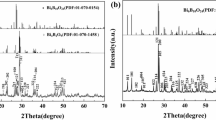Abstract
A new type of lithium bismuth phosphate 3Li2O–Bi2O3–6P2O5 (3L1B6P) microwave dielectric ceramics were prepared via a conventional solid-state route. Crystal structure, microstructure, microwave dielectric properties and aluminum electrode co-firing compatibility of the 3L1B6P ceramics were investigated. The 3L1B6P ceramics mainly consists of a new phase similar to the NdLiP4O12 with monoclinic structure [C2/C(15)]. The 3L1B6P ceramics are composed of BiLiP4O12 grains of ~ 10 μm in length and ~ 2 μm in width and BiPO4 grains of ~ 1 μm in size. The 3L1B6P ceramic sintered at 625 °C shrinkage and the corresponding microwave dielectric properties are dielectric constant εr = 6.8, Q × f = 16,900 GHz and negative temperature coefficient of resonant frequency TCF = − 71 ppm/°C. More importantly, the 3L1B6P ceramic with ultra-low sintering temperature (625 °C) can be co-fired with aluminum electrode, which illustrates it can be applied for the ultra-low temperature co-fired ceramic (ULTCC) application.








Similar content being viewed by others
Data availability
The datasets generated during and/or analysed during the current study are available from the corresponding author on reasonable request.
References
P.S. Anjana, M.T. Sebastian, J. Am. Ceram. Soc. (2009). https://doi.org/10.1111/j.1551-2916.2008.02756.x
H.H. Guo, D. Zhou, C. Du et al., J. Mater. Chem. C. (2020). https://doi.org/10.1039/d0tc00326c
X.-Q. Song, W. Lei, Y.-Y. Zhou et al., J. Am. Ceram. Soc. (2020). https://doi.org/10.1111/jace.16795
M.R. Gongora-Rubio, P. Espinoza-Vallejos, L. Sola-Laguna, J.J. Santiago-Aviles, Sens. Actuators A (2001). https://doi.org/10.1016/s0924-4247(00)00554-9
M. Gongora-Rubio, L.M. Sola-Laguna, P.J. Moffett, J.J. Santiago-Aviles, Sens. Actuators A (1999). https://doi.org/10.1016/s0924-4247(98)00238-6
Y.J. Cheng, Y.X. Guo, X.Y. Bao, K.B. Ng, IEEE Trans. Antennas Propag. (2014). https://doi.org/10.1109/tap.2013.2293152
T.H. Hsu, C.L. Huang, J. Eur. Ceram. Soc. (2021). https://doi.org/10.1016/j.jeurceramsoc.2021.05.033
J.Q. Ren, K. Bi, X.L. Fu, Z.J. Peng, J. Alloys Compd. (2020). https://doi.org/10.1016/j.jallcom.2020.153867
M.T. Sebastian, H. Wang, H. Jantunen, Curr. Opin. Solid State Mater. (2016). https://doi.org/10.1016/j.cossms.2016.02.004
Y.J. Gu, X.H. Yang, X.B. Ding et al., J. Mater. Sci.-Mater. Electron. (2020). https://doi.org/10.1007/s10854-020-04376-6
H. Zhou, X. Liu, X. Chen, L. Fang, Mater. Chem. Phys. (2012). https://doi.org/10.1016/j.matchemphys.2012.09.004
I. Kagomiya, Y. Kodama, Y. Shimizu, K.I. Kakimoto, H. Ohsato, Y. Miyauchi, J. Alloys Compd. (2015). https://doi.org/10.1016/j.jallcom.2015.03.245
S.-F. Wang, Y.-R. Wang, Y.-F. Hsu, J.-S. Tsai, J. Eur. Ceram. Soc. (2010). https://doi.org/10.1016/j.jeurceramsoc.2010.01.020
C. Pei, Y. Li, J. Tan et al., Ceram. Int. (2020). https://doi.org/10.1016/j.ceramint.2020.07.250
R. Naveenraj, E.K. Suresh, J. Dhanya, R. Ratheesh, Eur. J. Inorg. Chem. (2019). https://doi.org/10.1002/ejic.201801369
A. Sasidharanpillai, C.H. Kim, C.H. Lee, M.T. Sebastian, H.T. Kim, ACS Sustain. Chem. Eng. (2018). https://doi.org/10.1021/acssuschemeng.8b00656
D. Zhou, C.A. Randall, L.-X. Pang et al., J. Am. Ceram. Soc. (2011). https://doi.org/10.1111/j.1551-2916.2010.04312.x
S.-Z. Hao, D. Zhou, C. Du et al., ACS Appl. Electron. Mater. (2021). https://doi.org/10.1021/acsaelm.1c00193
E.-C. Xiao, J. Li, J. Wang, C. Xing, M. Guo, H. Qiao, G. Dou, F. Shi, J. Materiomics (2018). https://doi.org/10.1016/j.jmat.2018.08.004
I.-S. Cho, J.-R. Kim, D.-W. Kim, K.S. Hong, J. Electroceram. (2006). https://doi.org/10.1007/s10832-006-9883-3
E.-C. Xiao, Z. Cao, J. Li, X.-H. Li, M. Liu, Z. Yue, Y. Chen, G. Chen, K. Song, H. Zhou, F. Shi, J. Am. Ceram. Soc. (2020). https://doi.org/10.1111/jace.16933
I.-S. Cho, G.K. Choi, J.-S. An, J.-R. Kim, K.S. Hong, Mater. Res. Bull. (2009). https://doi.org/10.1016/j.materresbull.2008.03.016
J.I. Bian, D.W. Kim, K.S. Hong, JPN J. Appl. Phys. (2004). https://doi.org/10.1143/jjap.43.3521
D. Thomas, M.T. Sebastian, J. Am. Ceram. Soc. (2011). https://doi.org/10.1111/j.1551-2916.2011.04639.x
Acknowledgements
This work was supported by the Natural Science Foundation of Guangxi (No. 2019GXNSFBA185037), Science and Technology Base and Talent Special Project of Guangxi (No. AD19110017) and Guangxi Key Laboratory of Embedded Technology and Intelligent Systems (No. 2020-2-1).
Author information
Authors and Affiliations
Contributions
All persons who meet authorship criteria are listed as authors, and all authors certify that they have participated sufficiently in the work to take public responsibility for the content, including participation in the concept, design, analysis, writing, or revision of the manuscript using our scientific data. Furthermore, each author certifies that this material or similar material has not been and will not be submitted to or published in any other publication.
Corresponding author
Ethics declarations
Conflict of interest
There is no conflict of interest to declare.
Additional information
Publisher's Note
Springer Nature remains neutral with regard to jurisdictional claims in published maps and institutional affiliations.
Rights and permissions
About this article
Cite this article
Liu, X., Yang, S., Wang, H. et al. New lithium bismuth phosphate ceramic: crystal structure, microstructure, microwave dielectric properties and co-firing compatibility with aluminum electrode. J Mater Sci: Mater Electron 33, 10114–10120 (2022). https://doi.org/10.1007/s10854-022-08001-6
Received:
Accepted:
Published:
Issue Date:
DOI: https://doi.org/10.1007/s10854-022-08001-6



